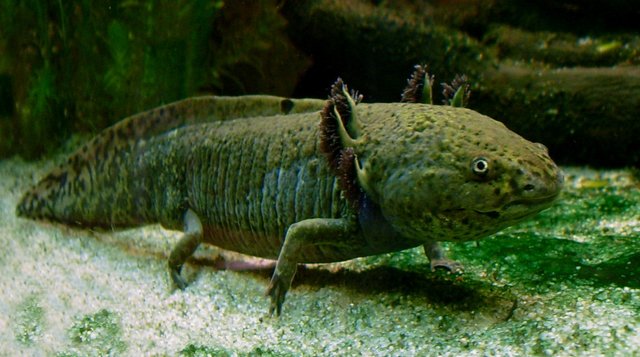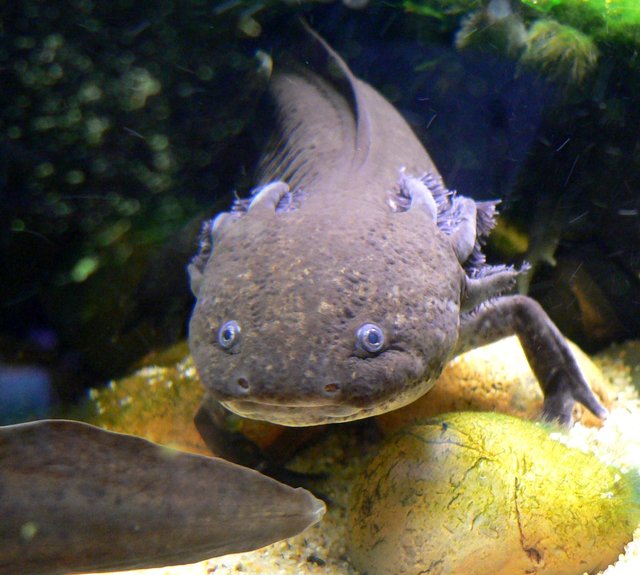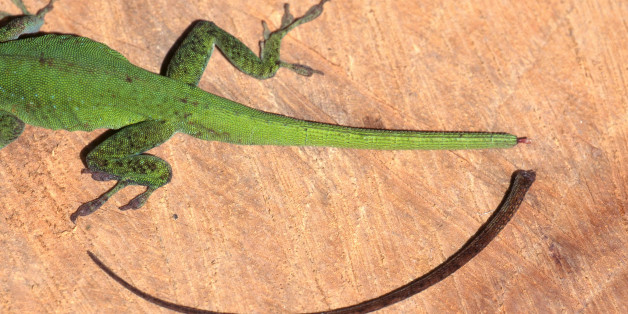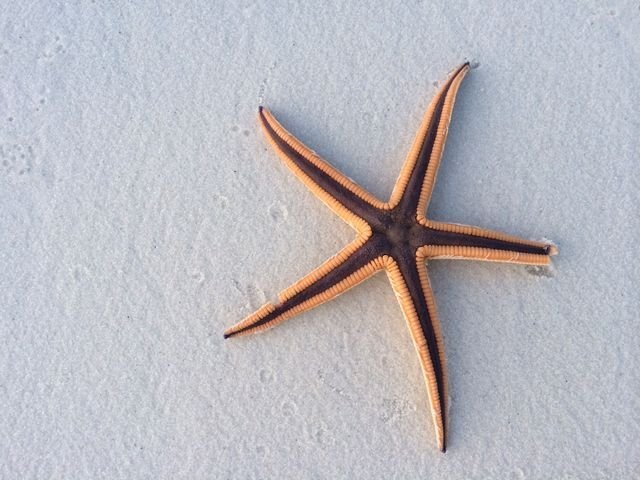The entire genome of the axolotl (Ambystoma mexicanum) has been sequenced, and might give us details about how it regenerate lost limbs and damaged organs
There are several species that are able to regenerate lost limbs, but the axolotl (Ambystoma mexicanum) is arguably the species that is best this regeneration. This little amphibian can not only regenerate lost limbs that it might lose in a battle, because he takes it one step further. An axolotl is actually capable of regrowing damaged organs! A study has shown that this include the ability to even regrow certain parts of its brain, a feature that has not been found in any other species.

An axolotl. Image by Wikimedia Commons user LoKiLeCh, posted with the Creative Commons Attribution-Share Alike 3.0 Unported license.
Since the axolotl has such unique abilities, it has been studied a lot by science, but it is also very popular to keep as a pet. It is considered critically endangered by the IUCN Red List, so maybe it’s a good thing that we have plenty of them in labs and aquariums all around the world. They are pretty common to find in pet stores, so just head over to one of these if you want to see how this guy looks like in real life.
Anyway, its ability to regenerate lost limbs and organs has made many scientists very interested in it, and they hope to uncover some secrets that could potentially teach us more about how this is done. The dream is of course to be able to replicate this feature to humans, but that is still far from possible with the technology we have today.
What exactly is an axolotl?
We have talked a bit about the axolotl’s ability to regenerate lost limbs and organs, but what exactly is this animal? For some reason people keep referring to it as a “walking fish” because of its limbs, but this is not true at all. It is in fact an amphibian, so the fact that it has legs instead of fins is not really surprising at all. If you want to see a fish with hands, check out the post I did about the Red Handfish a few days ago.
Unlike most other amphibians, the axolotl does not undergo metamorphosis from larvae to adulthood (like a frog does). What this means is that it never develop lungs, so even the adults have to stay aquatic in order to breath with heir gills.
In the wild you have to travel to Mexico to find them, and they are mostly found in small freshwater lakes close to Mexico City. Lake Xochimilco has wetlands around it, and these are typically where people go to look if they want to find one in the wild.
Cows grazing on some grass in the wetlands close to Lake Xochimilco. Image by Wikimedia Common user Jflo23, posted with the Creative Commons Attribution-Share Alike 3.0 Unported license.
The entire axolotl genome has been sequences
Scientists have just recently sequences the entire genome of the axolotl, and the findings have been published in Nature. While a “simple” genome sequestration might not seem like a big deal, the axolotl has a huge genome that has about ten times as many base pairs as the human genome, so it is a lot of work. It is currently the largest genome that has been sequences, so in many ways this is a feat by itself.

An axolotl at the Steinhart Aquarium in San Francisco. Image by Stan Shebs, posted with the Creative Commons Attribution-Share Alike 3.0 Unported license.
The paper has some interesting remarks, but they did of course not find the “secret” to regenerating lost limbs and organs by simply looking at the genome. It is of course mixed in there somewhere, but decoding the DNA from a long string of T, C, A and Gs is a lot of work!
It was previously known that the Prod1 gene has been contributing to the regeneration of lost limbs, but this new paper also identified other parts of the same gene family to be part of the function. The scientists have also found several other interesting regions of the DNA that they believe to be playing a part in the regeneration, so hopefully someone will be able to take a closer look at these parts in the future.
While the genome has been sequences, unlocking the information from it has only begun, and it will be very exciting to see if more papers are published about how it can regenerate limbs and organs. There are also other organisms who can do these types of regenerations (but rarely vertebrates), so one possible way forward is to compare the genomes of these organisms with each other to find parts that are the same.
Thanks for reading
Thanks for reading about the genome sequence of the axolotl! I hope you liked it, and make sure to leave a comment below if you got anything to share. If you want to learn more then follow the links in the post, but be warned, papers about genetics is almost unreadable by those who are not familiar with it.
your information is very useful that's a cool mythological story Thanks for stopping by and leaving a comment.
It would be nice if you would leave a comment that does not really sound like a copy-paste if you intend to upvote yourself to the top of the comment section.
Being A SteemStem Member
Thanks for the upvote, @steemstem :D
In primary school, our teacher had us look after and even breed Axolotls as class pets. They were absolutely amazing to me and from that year on, I had them in a huge tank at home.
They come in plenty of colours, but my favourite was always the albino, white ones with red gills. They were almost see-through in their bellies which was amazing to look at. Handling them out of the water was also great fun, especially as kids.
They weren’t very intelligent and we had to feed them these pellets by literally holding it between a finger and thumb literally 1cm from their nose and having them snap it out of your hand.
I remember one time we woke up to an Axolotl alive and floating at the top of the tank. We waited a day and asked a vet. He said that it was constipated and we should put it in the fridge over night. Woke up the next morning and it was totally fine and healthy again 😂😂.
They’re the strangest, but coolest animals and I’m excited to hear about the scientific studies on their ability to regenerate limbs. Looking forward to seeing what human medical advancement comes from my childhood pets! 😎
This was a great read, @forexbrokr! Thanks for sharing your story and your experience with this cool animal with the rest of us :)
It sounds really strange that the vet wanted you to put it in the fridge, but I guess that might be possible with amphibians. Still it sounds like a crazy advice :P
I am also very excited to see if we can make any medical advancement from these critters, and regrowing limbs and organs could be the holy grail for some disease. Imagine if we could create a system that would grow lungs or kidneys that we could harvest and donate to those who needed it! It's still very far from reality, but I'm excited about it!
Best regards from @valth
So basically we have found a Wolverine, haha. Alright on a serious note now, bioinformatics is still not so advanced in our world to decode or replicate the DNA of an axolotl for humans. An Iron Crab can regenerate it's limb after harvesting and other species like lizards can regrow their tail to some extent. However, it will not be the exact size or shape of the original.


Another interesting species is a 'Starfish' also called as 'Sea Stars'. Some species of the Starfish are known to regenerate a lost arm and some can regrow an entire disc from a single arm, it's so fascinating.
I hope in near future we will be able to see miracles in the field of medical science. Thank you for adding one more species to my knowledge.
Yeah, it's really amazing how some species are able to just regrow parts of them after losing them. As you say, we're still far away from being able to do anything useful with all this information, but this might be the first step towards achieving such incredible medical feats, so we should for sure keep studying these organisms!
Thanks for stopping by and leaving a valuable comment!
Yes, it is amazing. But, What I would love more is to witness such an event where humans are close to immortality. All the Fiction turning into science-backed reality would be amazing, we could actually be more like the characters we fancied in our childhood. Yes, it is the first step and I hope it happens sooner so this generation gets to witness it. Thank you for posting such an informative post so it made me stop and leave a comment. Cheers!
Hehe, that would really be amazing! :D
great information shared.i have also heard a weird thing about axolotol the Xolotl was a dog-headed god from Aztec mythology. God of all things grim, the deity would lead the souls of the dead to the underworld. As with all mythology, there a lot of mixed accounts about what happened next, but some believe that Xolotl was fearful of being killed and transformed into an axolotl to hide. The salamander is trapped in the water of Xochimilco, unable to transform and walk on land.
Oh wow, that's a cool mythological story! I had never heard about this before, so thank you very much for sharing it with me (and the other readers) :D
you are welcome:D
Wow these things are so amazing. Who'd have thought they'd have the largest genome sequenced so far? I remember reading about these when I was a kid and I thought they looked like the comedian Carrot Top lol Nature is endlessly fascinating.
Haha, yeah, they're really cool creatures! The length of the genome seems pretty random at times, so even some small animals can have huge genomes, while bigger ones don't necessarily have that big at all. Some types of plants even have genomes that are much larger than that of the axolotl.
Anyway, thanks for stopping by and leaving a comment!
Growing new damaged organs is pretty awesome, and while we are waiting for the scientists to find the secret, we can 3D print our organs :)
https://www.nature.com/news/the-printed-organs-coming-to-a-body-near-you-1.17320
3D printing organs is really cool, and I honestly believe that this will be the used technology (and not something made from biological processes) for recreating lost limbs. At least for a long while, and who knows what we are capable of doing in 50 years from now?
I bet we don't have a clue on what we can do in 50 years from now. Time travel? :P
Exactly, no one can know what type of technology we have at that point. Maybe creating new organs/limbs is not even needed anymore because we've found something better to replace it with? ;) Maybe a bit of a stretch for 50 years though, and time travel probably is as well. But who knows?
An interesting animal indeed.
If "we" are able to determine how the regeneration works on a molecular/biological level, do you think there are any applications in human medicine?
That's a very good question, @sco. I think it's a bit early to know if it has any real application, but we can of course hope. I think it might be useful in the future at one point when we have much better technology, but right now there's no way we can recreate this to use in the medicine industry.
Oh i have seen this specie for the first and i didn't even knew its name but your help me find more about such interesting species :)
I'm glad you learned about a new species, @munazza! These guys are really cool to read about, so you should totally check them out further if you found this post interesting :)
Yes i will check your blog to know more about species .You have a list of very interesting articles .I have gone through them But i will read in depth :)
You know i hate reading and writing before steemit but since i joined steemit here i found interesting articles .Now i love to read and write because everyday i came across a new thing :)
Thanks to you seniors for sharing your knowledge with us :)
Wow, that's cool! Steemit is really changing how people behave ;)
Yes there are few blogs that attracted me to love reading .Yours is one of them :)
Can you visit my blog to suggest me what to improve in my blog so that it attracts people like your blog :)
That's nice to hear!
I honestly don't know what will make a good blog or not; what I do is to work hard to try my best to make a good post every day. And it seems to be working fine for me, but it might not be working for everyone else. My suggestion is to just do what you're good at, and keep going even if you don't make much money at first.
Another amazing creature. I wonder why are we looking for secrets of these creatures. We have an ability to regenerate our livers. Isn't it easier to find a way to fully solve that and apply the feature to other organs. Don't know it's really confusing and my biology knowledge goes back to high school which i graduated 10 years ago :D
And it's a bad idea for people to pet these creatures since they are going to cut their limbs and watch them grow again.
When scientists want to find new solutions to problems, such as trying to figure out how to regrow limbs or organs, the best way forward is to gather as much knowledge about the possible solutions as possible. It is much better to study a lot of different mechanisms to regrowth rather than just focusing on one, because they have a much higher chance of finding one solution that actually works by having many options.
Hopefully no one will do that :O